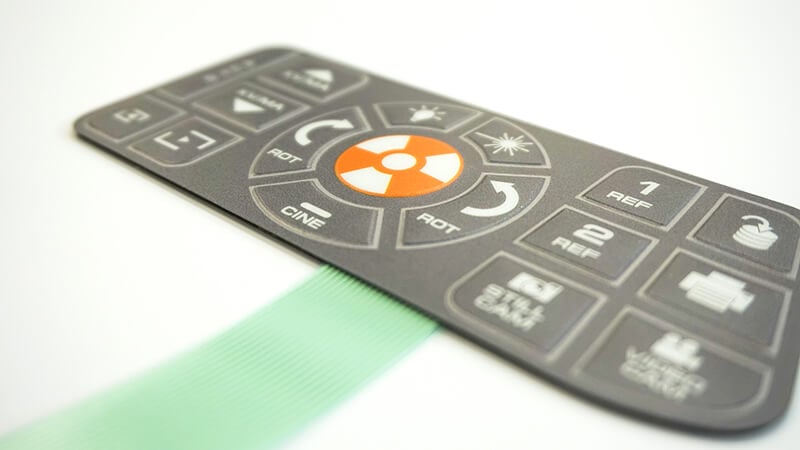Understanding the Capability of Membrane Layer Switches for Interface Instruments
The functionality of membrane layer switches over stands for a considerable innovation in interface design, integrating effectiveness with visual versatility. These buttons run via a multi-layered structure that converts customer interactions into electrical signals, enabling both small formats and durability versus ecological factors. As sectors progressively focus on individual experience, comprehending the nuances of membrane button modern technology ends up being essential. What implications do these advancements hold for future applications, and exactly how might they redefine customer interactions across different gadgets?
What Are Membrane Buttons?
Membrane switches are cutting-edge interface devices that promote customer communication with digital devices. These versatile elements are composed of several layers, consisting of a graphic overlay, spacer, and a published circuit layer. The style permits a smooth assimilation into different digital tools, boosting both the visual and useful facets of customer interfaces.
Membrane layer buttons are typically used in a vast array of applications, from house home appliances to industrial machinery and medical tools. Their construction usually includes a slim account, making them a suitable choice for small layouts. The tactile responses offered by these switches can be engineered to satisfy specific user choices, ensuring efficient communication between the customer and the gadget.
Resilience is an additional significant advantage of membrane layer switches, as they are resistant to dirt, dampness, and chemicals, which enhances their life-span sought after atmospheres. In addition, these switches can be customized in regards to form, dimension, and graphic style, permitting branding and user-specific functions. On the whole, membrane switches over stand for a functional solution for improving customer experience in digital gadgets, incorporating functionality with aesthetic charm in a reliable manner.
How Membrane Switches Work
Operating on an uncomplicated principle, membrane layer switches over make use of a layered construction to sign up user input successfully. Each switch contains numerous layers, including a published circuit layer, a spacer layer, and a top graphic layer, which are created to interact flawlessly. When a user presses the top layer, it presses the spacer layer, bringing the conductive elements of the circuit layer into contact with each various other.
This call develops a shut circuit, signaling the tool to implement a specific function. The style permits various setups, consisting of responsive comments, which can improve the customer experience by giving a physical feeling upon activation. The materials made use of in membrane switches commonly consist of versatile substratums, such as polyester or polycarbonate, which guarantee longevity and resilience versus damage.

Key Benefits of Membrane Buttons

An additional considerable benefit is their density. Membrane buttons are thin and light-weight, which allows makers to conserve area in their devices without compromising functionality. This attribute is especially valuable in applications where weight and volume are critical factors to consider.
Furthermore, membrane layer switches are resistant to dirt, moisture, and chemicals, improving their durability. This strength extends their life-span and decreases the demand for frequent substitutes, resulting in expense financial savings gradually.
Moreover, the tactile responses offered by membrane layer switches can be enhanced to boost user communication. They can consist of features such as increased switches or audible clicks, enhancing use and user experience.
Applications Throughout Industries
User interface devices using membrane layer switches prevail in a vast range of sectors, showcasing their flexibility and functionality. Membrane Switch. In the medical market, membrane layer buttons are integral to devices such as diagnostic equipment and client surveillance systems, where their durability and simplicity of cleansing are vital for keeping hygiene requirements. Likewise, in the vehicle market, these switches are utilized in dashboard controls and infotainment systems, offering a smooth and contemporary interface for individuals.
Furthermore, the consumer electronics industry take advantage of membrane switches in appliances and portable tools, i was reading this where portable style and easy to use interfaces improve user experience. Industrial applications also leverage membrane changes for control panels in machinery and automation systems, emphasizing their effectiveness and resistance to rough settings.
In the aerospace and defense industries, membrane switches are made use of in cabin controls and devices, where reliability and efficiency under extreme problems are vital. Furthermore, the video gaming market increasingly includes membrane switches in controllers and arcade machines, adding to an engaging customer experience. On the whole, the versatility of membrane switches over enables their widespread usage across numerous markets, highlighting their significance in modern interface style.
Future Fads in Membrane Layer Switch Modern Technology

Furthermore, making use of advanced products, such as polycarbonate and polyester movies, is expected to rise, giving enhanced toughness and resistance to ecological stressors. These materials contribute to the general longevity of membrane buttons, making them ideal for harsher commercial applications.
Moreover, the consolidation of wise innovation, consisting of IoT connection, will certainly make it possible for membrane layer switches to communicate with other gadgets and systems, assisting in an navigate to these guys extra interactive customer experience. This fad straightens with the expanding need for smart devices across various sectors, from healthcare to consumer electronics.
Lastly, customization options are anticipated to expand, allowing manufacturers to create bespoke solutions customized to details customer demands and choices. These advancements will position membrane buttons as essential parts in the advancement of interface modern technology.
Verdict
To conclude, membrane layer changes represent a crucial innovation in interface innovation, providing a trustworthy and flexible remedy for varied electronic applications. Their split building helps with compact layout, while features such as responsive responses improve user communication. The sturdiness against ecological elements further strengthens their utility throughout multiple sectors. As improvements in material scientific research and touch sensing modern technologies continue, the capability and applicability of membrane go to this web-site buttons are expected to increase, reinforcing their value in contemporary digital devices.